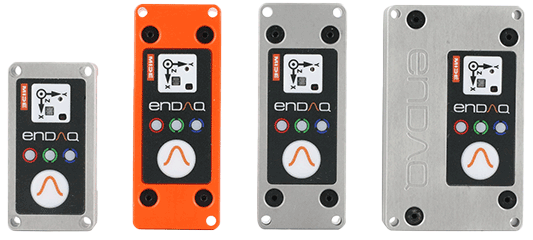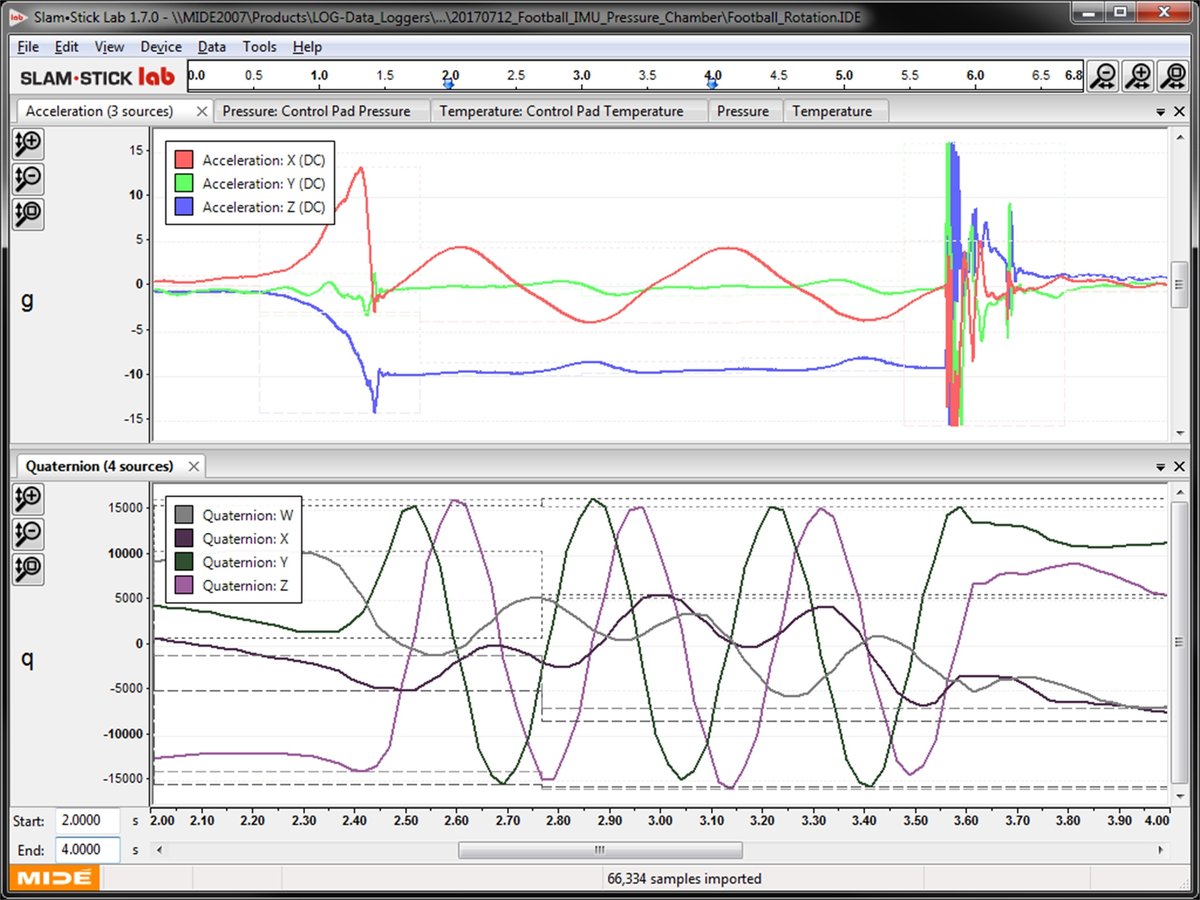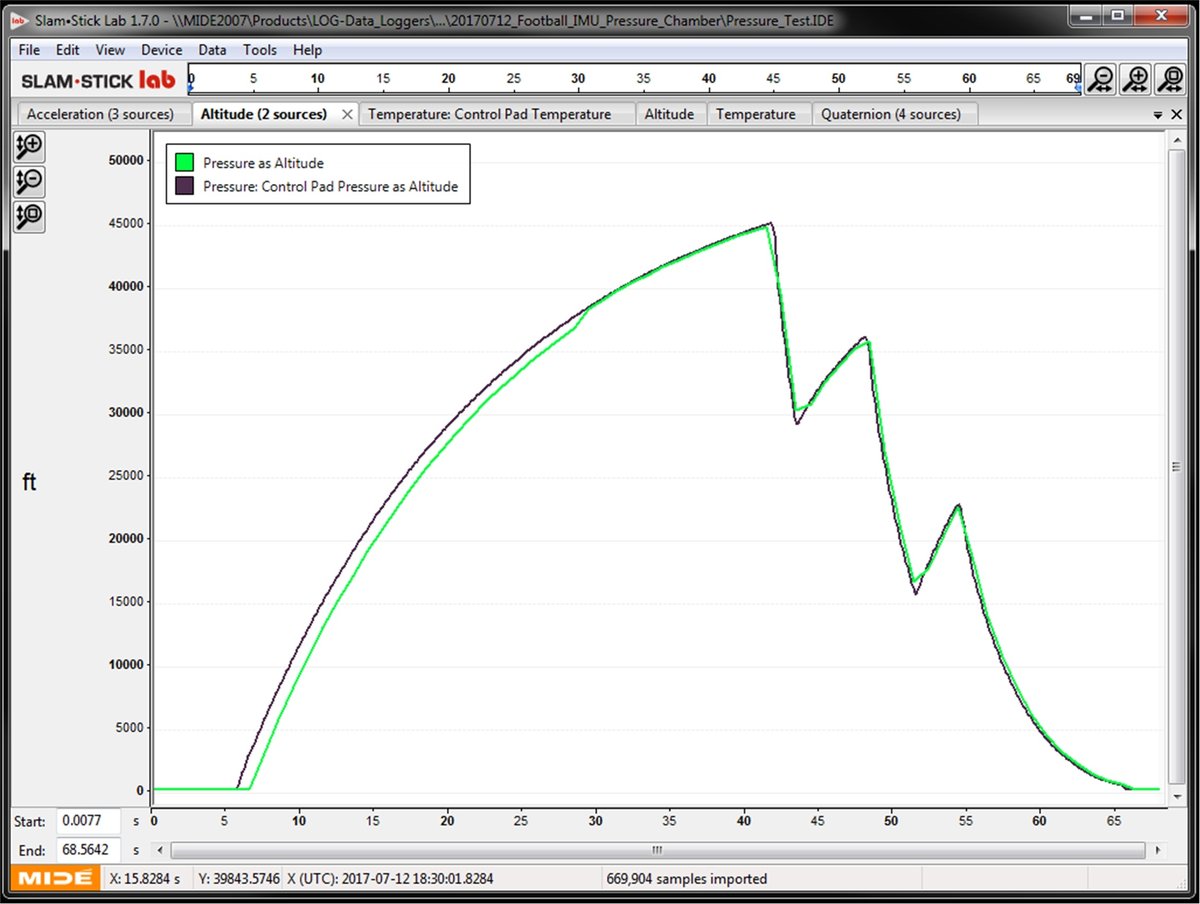
The current enDAQ sensors (formerly Slam Stick vibration data loggers) have a lot of sensor channels... but we wanted more.
In this post, I'll introduce the two new sensors that will begin to be included, at no additional charge, on all units beginning September 1st.
9-Axis Absolute Orientation Sensor
A lot of customers have asked for a gyroscope to be included in their enDAQ sensor (formerly Slam Stick recorder) to get accurate rotation information. Over the last year, we reviewed many of the sensors available and selected a sensor that contains a three-axis gyroscope and another triaxial accelerometer and a triaxial geomagnetic sensor. This sensor is manufactured by Bosch, the BNO055.
What's most exciting about this sensor is that the device also contains a 32-bit microcontroller to run a sensor fusion algorithm. This allows the sensor to accurately report the absolute orientation of the device and enDAQ will provide the option of outputting quaternion data. Here's a link to the sensor's data sheet with more information.
We will be doing a whole blog series and a few case studies to showcase this new exciting sensor; but below is a quick teaser video with the enDAQ sensor mounted to a rotating football. And Figure 1 includes a plot of the data.

What is Quaternion?
Many of us can conceptualize Euler angles, three rotations around perpendicular axes. But if two of these axes ever become aligned then you can have something called gimbal lock (more on this later). Quaternions contain 4 numbers (a three component vector and one scalar). This ensures there is never gimbal lock but at the expense of making it much more difficult to conceptualize what the numbers mean. But with modern computing and tools like WolframAlpha we can easily process the data to visually describe the sensor's orientation. This is not currently supported in the enDAQ Lab (formerly Slam Stick Lab) but will be soon. For more information on Quaternion, check out this article from All About Circuits.
And remember, this sensor can output the raw 9-DOF data for folks interested primarily in one or all of the individual sensors. The enDAQ sensor will be configurable to output either Quaternion or raw 9-DOF.
New Ambient Pressure & Temperature Sensor
The current enDAQ sensors all include an internal temperature and pressure sensor. Mide (enDAQ is a division of Mide) had added this sensor in the initial development to compensate the gain of the accelerometer that is influenced by temperature. Mide had developed the Slam Stick (now enDAQ sensor) for the US Navy and they have a large number in their possession. Recently, with the cabin pressure issues they've been having in F/A-18s, they have been using the device to record pressure. But they desired a better pressure sensor...
The current pressure/temperature sensor has a few shortcomings:
- It only samples at 1 Hz
- It is inside the enclosure so the response to ambient conditions is delayed
- It had an operational pressure range down to only 20 kPa, and its calibrated range was down to 50 kPa
- This equates to an altitude of 38,000 and 18,000 ft
Mide identified a much better combination sensor that also includes humidity, TE's MS8607. This sensor has a number of improvements:
- User selectable sample rate between 1 Hz and 10 Hz
- Calibration range to 30 kPa (30,000 ft) and operational range down to 1 kPa (> 65,000 ft)
- Mide also embedded the sensor inside the "control pad" that houses the button and LEDs on the outside of the enclosure. This allows the sensor to more directly measure ambient conditions.
Figure 2 plots the new and old pressure sensor data for when the device was inside a vacuum chamber. The new sensor is clearly more responsive to changing pressure and with its faster sampling, able to more accurately record fast changing pressure. More information on this sensor is available in its data sheet.

Show Me the Data!
These short recording files are available to download » Download Recording Files.
The enDAQ Lab software is also freely available to download and view the data. I encourage you to check out these new sensors, hopefully, you're as excited as I am to begin testing with these to gain a deeper understanding of your test environment. Don't hesitate to reach out and ask any questions!
For more on this topic, visit our dedicated Environmental Sensors resource page. There you’ll find more blog posts, case studies, webinars, software, and products focused on your environmental testing and analysis needs.
